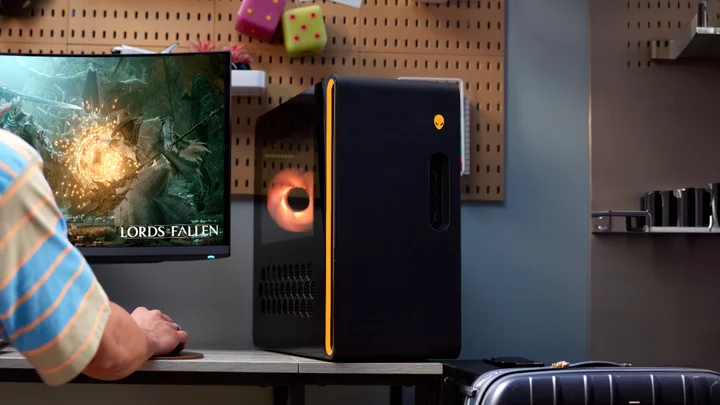It was past time for an alien makeover. Dell's Alienware just announced the next edition of its powerful Aurora gaming desktop line, the Alienware Aurora R16. It packs the latest Intel and Nvidia components inside an entirely new tower chassis design. But the bigger news is the new look.
We’ve reviewed plenty of Aurora desktops at PCMag in the past, and the case design always stood out from the pack. Alienware's bold look, while appealing to some, has certainly been a divisive (not to mention physically large) departure from traditional tower design. This new style goes in a more mainstream direction, with a much sleeker and more modern tower aesthetic. Available today starting at $1,749, the Aurora R16 also has plenty of additional configuration options to choose from before checkout.
This update isn't all about the fresh tower, either: The Aurora R16 can pack up to 13th Generation Intel Core i9 processors and an Nvidia GeForce RTX 4080 GPU. Dell has bragged about some performance gains in the new tower design itself as well, though you'll still find some drawbacks to Alienware’s proprietary build—something these Alienware cases can't seem to get away from.
Aurora Overhaul: Meet the Sleeker, Smaller Tower
First, that new tower: The most recent Alienware Aurora R15 model was created as part of Alienware’s Legend 2 design language, keeping in sync with the laptops of the same style. Like the most recent laptops this year, the R16 is shifting to the Legend 3 styling, and it’s a noticeable departure.
The previous Aurora R15 (left) versus the new R16 (right) (Credit: Dell)While the sci-fi white and geometric look of the R15 would appeal to some, it’s far from universally loved and outside of the norm for desktop design. The R16 (like Alienware's most recent laptops) has a much sleeker look, leading with darker color schemes across a more mainstream tower shape—but it does keep some of the Alienware Legend flair. The honeycomb side vents and ringed LED are the chief holdovers of this look.
(Credit: Dell)It’s not all just style, either: This tower is much smaller and has more efficient airflow than before. The extra plastic in the overall frame of the R15 made for a chunky tower, so the R16 cuts down on total volume by roughly 40%, while keeping the same internal 25.5-liter volume.
The design-related performance gains come primarily in the form of improved airflow, with CPU and GPU temperatures dropped by up to 10% and 6%, respectively, according to the company, but Alienware also claims up to a 20% quieter system. Loud fan noise was a specific flaw noted in our Aurora R15 review, so it's a welcome change.
(Credit: Dell)A ringed LED that Alienware calls the “Stadium Loop” is not just aesthetically pleasing but outlines a vent with a larger air intake than the older generation. Plus, a larger top vent and optimized cable layouts further help air flow through the case. All of this increased attention to detail has more in common with boutique PC makers—like Falcon Northwest, Maingear, Origin, and Velocity Micro—than many big manufacturers.
(Credit: Dell)Here's the catch: Alienware has stuck with proprietary (not ATX or SFX) power supplies and motherboards in this system, which severely limits future upgrades. The motherboard, for one, actually runs up to the front panel and directly populates the front panel ports, unlike a standard ATX motherboard.
Now, plenty of PC gamers are happy for a plug-and-play desktop, and they'll run it until the wheels fall off before eventually buying a new system. However, many hardcore gamers are interested in the long-term life, repairability, and upgradability of their gaming PCs. Introducing proprietary parts limits compatibility with new replacement parts and introduces unnecessary difficulties in replacing failed parts.
Configurations and Components: 13th Gen Intel and Nvidia RTX 40 Series Combine
That $1,749 starting price is a bit expensive compared to general-use desktops, but it's reasonable for a gaming desktop aimed at hardcore gamers. The base model comes with an Intel Core i9-12900F CPU, 16GB of DDR5 RAM, a 1TB SSD, and an Nvidia GeForce RTX 4070. The clear side panel and liquid-cooling benefits are also included in this price.
(Credit: Dell)Being a Dell product, the Alienware m18 has myriad configuration options from there. The other processor options include the Core i7-13700F and Intel Core i9-13900F. On the GPU front, you can bump the GPU up to an Nvidia GeForce RTX 4070 Ti, and in some regions, even an RTX 4080. (In Asia and Europe at launch, an Nvidia GeForce RTX 3050 base model will also be available.)
Memory goes from 16GB to 64GB of DDR5, via two U-DIMM slots. Storage options range from a single 512GB SSD to SSD-and-hard-drive combos adding up to as much as 8TB of total storage, with plenty of possible mixes in between.
(Credit: Dell)The power supply comes in either 500-watt or 1000-watt forms, and you can mix either with air or liquid cooling, as well as a clear or solid side panel. The connectivity includes Wi-Fi 6E as standard, as well as Killer Ethernet for wired. As for ports, the case includes four USB Type-A ports and two USB Type-C ports, while the video-out connections will be determined by your choice of graphics card. Check back for a full Alienware Aurora R16 review following the August 3 launch date.

